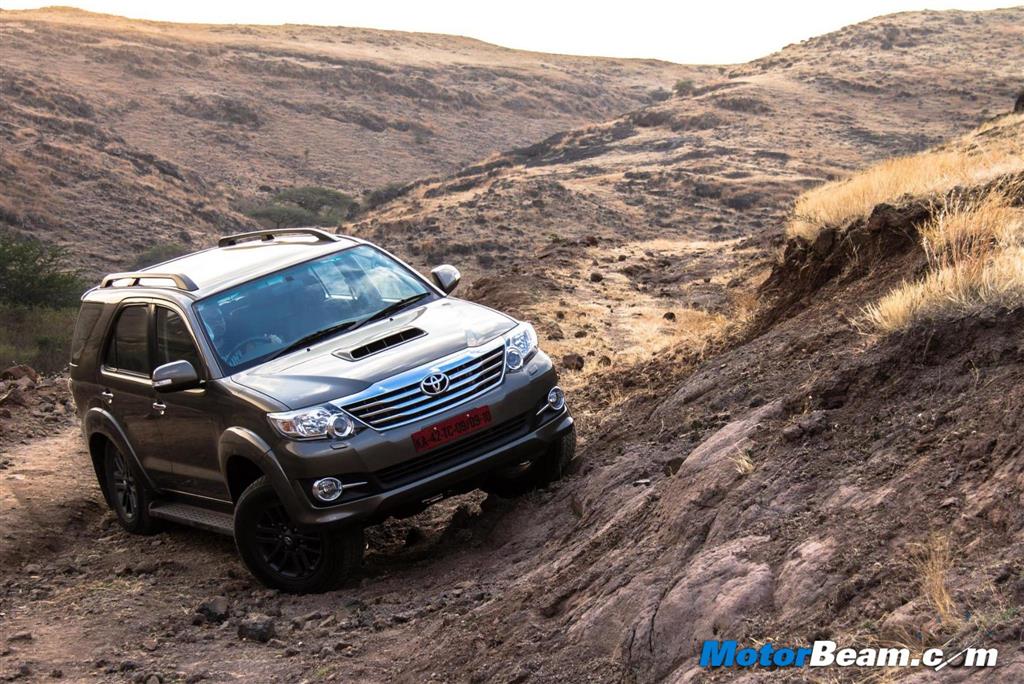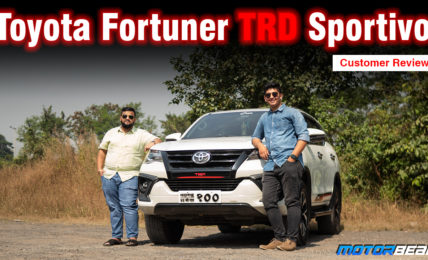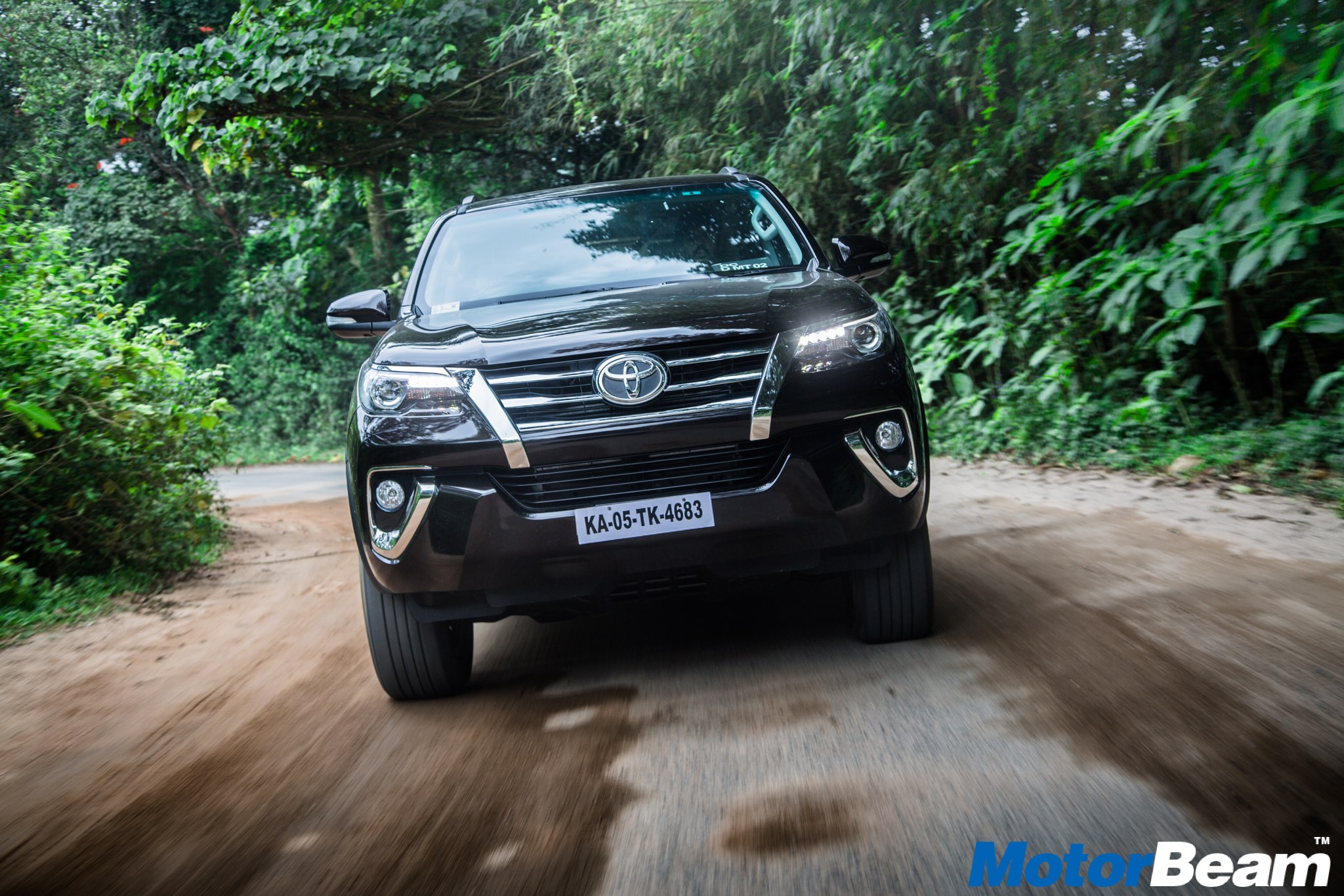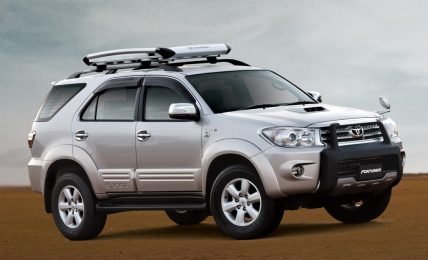
Toyota Fortuner Review
Car Tested: 2015 Toyota Fortuner 4×4 AT
Price OTR Mumbai: Rs. 29.75 – 32.59 lakhs
The Fortuner has terrific road presence, a powerful engine and is quite capable off-road
Indians love SUVs and there is no denying this fact. Why do we love these giant vehicles? Because they provide us with space, power and go-anywhere capabilities? Not exactly. While these factors do come into account while purchasing an SUV, what matters to most Indians is the amount of road presence that a vehicle has. The Fortuner is big with some bling and no two-wheeler or rickshaw or even a mid-size car would dare to cut across this huge SUV. Toyota launched the Fortuner way back in 2009 and sales kick-started to a great response. The waiting period was so high that buyers were ready to pay some extra moolah to get their hands on the T-Fort quickly. The Fortuner didn’t have any proper rival apart from the Mitsubishi Pajero at that time. Since we are in 2015 now, many things have changed. The Fortuner has better rivals, the vehicle itself has received quite a lot of changes and its price has jumped up by almost a million bucks. But what hasn’t changed is the fact that the SUV still sells in hot numbers month after month. Now Toyota has given the Fortuner a final update before replacing it with an all new model.
Motor Quest: After being launched in 2009, the Toyota Fortuner received one major cosmetic update which made the aggressive-looking SUV even better in terms of styling. Toyota though, loves skimping on creature comforts in a vehicle that costs more than Rs. 30 lakhs. However, the Fortuner has proved to be a very reliable vehicle.
The Fortuner has very imposing looks and not something you would want to mess with
Exteriors – The Toyota Fortuner has very aggressive looks and the styling is really butch. While rivals like the Hyundai Santa Fe carry a more premium styling layout, the Fortuner straight away looks robust. The front fascia of the 2015 model is very similar to the previous update. The bumpers, headlights and grille are all the same and Toyota has only redesigned the fog lamp housings this time. You can now find a small chrome strip next to each fog lamp and it looks striking yet subtle. The side profile hasn’t changed much and the only difference that you can see is the fact that the alloys now come finished in a shade of dark grey (almost black). The paint on the alloys has a matte finish and these wheels just add to the character of the vehicle. The SUV got lots of glares from people on the road, especially other Fortuner owners.
The rear is quite huge but the tail light looks like an after-market unit
The spare wheel has been mounted below the rear bumper so removing it could be quite a task for people who are slightly on the healthier side. The rear also gets mildly changed tail lamps. The earlier tail lights had a clear lens with white accents but the new lights come with black accents. Somehow we feel that the lights look like those available in the after-market and Toyota should have stuck to providing simpler lights. These changes are again minor and easy to miss out. Also, Toyota has stuck four badges at on the hatch gate of this particular variant – 3.0, D-4D, Full Time 4WD and Automatic.
Interiors are now full black and look better than the earlier beige ones
Interiors – Open the door and step inside the first thing that you notice are the full-black interiors. The earlier model had brown/beige interiors which were strikingly similar to the Innova. The black dashboard looks decent enough and it gets silver accents on the centre console, steering wheel, etc. The Fortuner gets an updated audio system that has a touchscreen head unit with features like USB and AUX-in support, Bluetooth pairing and in-built navigation. We used the infotainment system extensively and frankly came out very disappointed. First of all, the touch response from the screen is less than satisfactory. Secondly, while scanning for FM stations is easy, saving these stations is quite a task. But the sound quality given out from the stock speakers is good enough and most buyers won’t feel the need to upgrade. The system also has a reverse display and it is very helpful.
The instrument cluster is simple and easy to read but a bit basic for the price
The Fortuner is huge on the outside as well as the inside. There is oodles of space inside the cabin
The driver’s seat is big and provides a fair amount of comfort for the back and thighs. The seat cushioning is a bit too stiff so it causes slight discomfort while driving for long durations. The seats get electric controls for front and back movement and back rest angle. The rear seats are again decent enough on space and even tall people won’t face much of an issue while sitting at the rear, provided that the front seat isn’t pulled back completely. The rear seat gets an armrest which comes without any cup holders. The third row of the Fortuner is low on space and it would be criminal to make even mid-sized people sit there for long distances. Such seats are suited only for children. Also, the third row gets the rear-quarter window which is too small.
The Toyota Fortuner is high on space in the first and second rows
The leather seats get black fabric with white stitching and this theme is carried forward on the door trims also. The instrument cluster is fairly easy to read and displays the current gear selection (P, R, N, D, D4, D3, D2, L) but it doesn’t show what gear is the vehicle driving on while it is in D mode. The steering wheel gets audio controls and the Fortuner now also gets voice commands which are not very user-friendly to use. The SUV has lots of storage spaces in the centre console apart from a retractable cup holder each under the left and right side of the AC vents. Rear seat passengers get two cup holders which pop out from under the front armrest.
With the third row folded, a lot of cargo space gets freed up, it is best used this way
The pedals are placed nicely and there is a small dead pedal on offer too. All the switches and indicator stalks are within easy reach and there’s not much to complain on the ergonomics front. With all the three rows in place, the Fortuner loses out on boot space but if you’re travelling with even the third row folded, then a very generous amount of space is freed up. With both the rows folded down, the amount of cargo space available is amazing. The vehicle gets automatic climate control and the AC really chills the cabin. Vents are provided for the front passengers, second row as well as third row passengers.
The 3.0-litre engine provides good performance but NVH isn’t what it should be
Performance – The 2015 Toyota Fortuner comes with 2.5-litre and 3.0-litre diesel engines. The one which we drove was the 3.0-litre variant that also gets full time 4WD and a 5-speed automatic transmission. Talking about output first, the engine produces 171 PS of power and 360 Nm of torque. Driving the Fortuner is as effortless as it gets. The engine generates good power on the tarmac and power delivery is more than good. The torque that is generated just after letting go off the brake pedal is enough to get a good start from stand-still. A mild press on the accelerator is all that is required to drive around the city. Acceleration from 0-100 km/hr is pretty quick at 10.99 seconds as per our VBOX tests.
The Fortuner has enough punch for the city as well as highways alike
The 3.0-litre D-4D unit is punchy and power delivery is satisfactory but the autobox lets it down
Cruising on the highway is again easy thanks to the punchy engine and the cruise control feature. While cruise control cannot be used on a regular basis on our roads, an empty highway would be the place of choice where you would want to activate the cruise control and let your right leg have some rest. The 3.0-litre D-4D engine is capable of touching speeds well above the ton very effortlessly but the Fortuner really loses out thanks to the lazy 5-speed transmission. The gearbox takes time to change gears and if you put pedal to the metal to overtake someone, the Fortuner first revs a bit and then the transmission goes down one gear. The gearbox has the following drive modes – D, D4, D3, D2 and L. We used D most of the times and it worked well. D2 was put in use while climbing up steep inclines.
Thie Toyota feels completely at home off-the-road too
The variant which we drove gets full time 4WD and it would really mean injustice to the car if we didn’t go off-roading. The high ground clearance helps a lot in tackling uneven surfaces. The Dunlop tyres have more than satisfactory levels of grip on tarmac as well as off the road. The Fortuner managed most of the off-roading on the H mode. While we couldn’t try the HL mode, the LL mode was definitely put in use when the mammoth SUV got stuck in mud and the left rear wheel had zero traction. The LL mode helped the Fortuner crawl up and we managed to get the vehicle on three wheels, with the left rear wheel hanging in the air. Talking about braking, we must say that the Fortuner really disappoints with its pathetic braking capabilities. This SUV costs more than Rs. 30 lakhs and the least Toyota could do was provide rear discs. The Fortuner 3.0-litre 4×4 AT has an ARAI-claimed fuel efficiency of 11.9 km/l but we extracted only 7.5 km/l after some spirited driving, while a figure of 8.5-9 km/l was achieved with sedate driving.
The ride quality is less than satisfactory on the Fortuner
Driving Dynamics – Now this is a giant SUV and we cannot expect it to handle like a low-slung hatchback or a sedan. The Toyota Fortuner drives well and the steering feel is very neutral. Toyota could maybe tune it to provide more feedback. Also, the steering is slightly on the heavier side which is a boon on the highways and a bane in the city and while parking. The front seat offers great visibility and the view is very commanding. The side windows too aid in providing good visibility all around and hence despite of having a large footprint, the Fortuner is fairly easy to manoeuvre around in the city.
The SUV remains stable and quite composed at triple digit speeds
Speeds like 80-90 km/hr cannot even be felt inside the cabin and at speeds well above the ton too the Fortuner remains pretty much composed and predictable. Taking corners at high speeds induces a lot of body-roll which is again a feature of all vehicles with a high centre of gravity. The ride quality is terrible and we must say that the Innova just trumps the Fortuner in this department. The ride feels very choppy over rough roads and not everyone would fancy it. The front of the SUV gets a double wishbone axle while the rear has a four-link axle with lateral rod. The Fortuner has a minimum turning radius of 5.9-metres.
The Fortuner is seriously lacking on the safety front, it is under-equipped
Safety and After Sales Service – The Toyota Fortuner gets only dual front airbags, ABS with EBD and VSC (Vehicle Stability Control). This is downright surprising that Toyota, a leading Japanese auto giant is skimping on safety features on an already over-priced vehicle. This comes at a time when buyers are learning more and more about safety features and preferring more of them in their cars. Toyota should have used this opportunity to equip the Fortuner with at least four airbags, if not six. The VSC can be switched off but it turns on again on its own after the vehicle reaches a certain speed (approximately 20 km/hr). Toyota has a good reputation for after-sales service in India and the company is also known for its bullet-proof reliability. Buyers know this fact and reliability and ease of maintenance are one of the few reasons why the Fortuner as well as the Innova are selling so much. Toyota is slowly expanding its network across various cities in the country and buyers can be rest assured that they won’t face any issues with the servicing of their vehicles.
The Japanese vehicle has many rivals but none are able to affect the Fortuner’s sales
Verdict – The Toyota Fortuner is one hot-selling SUV and despite of all its shortcomings, it still continues selling in large numbers every month and this trend is going to continue for a long time to come. The Fortuner offers no creature comforts, poor brakes, poor safety features and the interiors largely resemble the Innova but buyers are enticed by the road presence and snob value that the Fortuner gives them. Hardly anyone cares about the vehicle’s off-road capabilities. Looking at the 1000-odd units that the Fortuner manages to sell every month, we don’t think customers are really cribbing about missing out on these things. The Fortuner has a very tough competitor, the Hyundai Santa Fe which is actually a much better choice here but is priced higher. The Fortuner doesn’t seem worth the price it commands and it should be bought only to satisfy the ego in you for having a vehicle that can bully anyone on the road.
The Toyota Fortuner is a not so value-for-money package with more negatives than positives. But the fact is that it still sells well in large numbers and even better competitors like the Hyundai Santa Fe haven’t managed to create even a small dent in its sales. The next generation Toyota Fortuner will be introduced in the market in 2016 and is worth waiting for.
The Fortuner is a buyers’ favourite in this segment due to its looks and Toyota name
What’s Cool
* Amazing road presence thanks to the huge size
* Reliability and ease of ownership is a feature of all Toyotas
* Powerful engine which provides satisfactory power for city, highway and off-road use
* Lots of space inside the cabin
* Large windows and windshield give an airy feel to the cabin
* Alloy wheels finished in matte black look amazing
* Quite competent off the road
What’s Not So Cool
* Poor safety features not expected on a Rs. 30-odd lakh SUV
* Ride quality is poor over even slightly uneven road surfaces
* Equipment and feature list is shockingly low for a vehicle of this segment
* Engine is too noisy and most of it is audible inside the cabin too
* The interiors continue to remind us of the cab friendly Innova
Alternatives: Hyundai Santa Fe, SsangYong Rexton, Renault Koleos
The next generation Toyota Fortuner will make it to India early next year
Toyota Fortuner Specifications
* Engine: 3.0-litre D-4D diesel engine
* Power: 171 PS @ 3600 RPM
* Torque: 360 Nm @ 1400-3200 RPM
* 0-100 km/hr – 10.99 seconds (VBOX test)
* Transmission: 5-speed automatic
* Fuel Consumption: 8-9 km/l
* Fuel Type: Diesel
* Suspension: Double wishbone front axle and four link rear axle with lateral rod
* Tyres: 265/65/17
* Brakes: Ventilated Disc (Front), Drum (Rear), ABS
* Safety: ABS, two airbags and VSC
Toyota Fortuner Dimensions
* Overall length x width x height: 4705 mm X 1840 mm X 1850 mm
* Wheelbase: 2750 mm
* Ground clearance: 220 mm
* Fuel Tank Capacity: 80 litres
* Kerb Weight: 2000 kgs




